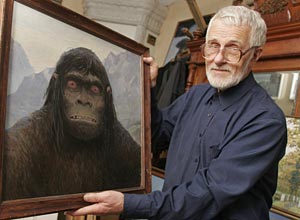
October 1, 2007

Palaeoarchaeological findings appear to be catching up to hominology, the segment of cryptozoology studying unknown hominoids.
For some time, a few of us have studied various reports of what might be surviving Neandertals* in Siberia and China. Whether called Mecheny, Mirygdy, Chuchunaa, Mulen, or Wildmen, some Soviet Snowmen Commission scientists and a few Chinese in the last century theorized we might be dealing with relict populations of Neandertals. Especially intriguing are the Chuchunaa, the often clothed, eastern version of the Mirygdy, seen in Eastern Siberia.
(Perhaps further research will also show the fossil Neandertals were a bit larger in their southern and eastern range than in the north, also mirroring the hominological reports?)
In a new study published in Nature, hominid fossils, some as young as 28,000 years old, from Siberia, near China, have been said to show the range of Neandertals is more vast than previously thought.
The highlights of one AFP wire service article about this notes:
Remains from the slope-browed hominid have previously been found over an area stretching from Spain to Uzbekistan, but the new study extends the eastern boundary of their wanderings another 2,000 kilometres (1,250 miles) deep into southern Siberia, just above the western tip of what is today China.
. . .
Geneticist Svante Paabo of the Max Planck Institute for Evolutionary Anthropology and colleagues compared mitochondrial DNA (mtDNA) sequences from bones found from two sites — one in Teshik Tash, Uzbekistan and the other from the Altai Mountains in Siberia — with those of specimens from different European sites.
. . .
The study, published in the British journal Nature, confirms that the adult fossils — about 40,000 years old — from Okladnikov Cave in Siberia genetically match the European Neanderthal.
. . .
The presence of Neanderthals in Siberia “raises the possibility that they man have been present even farther to the east, in Mongolia and China,” the study notes.Smaller and squatter than modern man, Neanderthals lived in parts of what are today Europe, Central Asia and the Middle East for around 170,000 years.
The abstract from Nature summarizes, thusly:
Morphological traits typical of Neanderthals began to appear in European hominids at least 400,000 years ago and about 150,000 years ago in western Asia. After their initial appearance, such traits increased in frequency and the extent to which they are expressed until they disappeared shortly after 30,000 years ago. However, because most fossil hominid remains are fragmentary, it can be difficult or impossible to determine unambiguously whether a fossil is of Neanderthal origin. This limits the ability to determine when and where Neanderthals lived. To determine how far to the east Neanderthals ranged, we determined mitochondrial DNA (mtDNA) sequences from hominid remains found in Uzbekistan and in the Altai region of southern Siberia. Here we show that the DNA sequences from these fossils fall within the European Neanderthal mtDNA variation. Thus, the geographic range of Neanderthals is likely to have extended at least 2,000 km further to the east than commonly assumed.Neanderthals in central Asia and Siberia, by Johannes Krause, Ludovic Orlando, David Serre, Bence Viola, Kay Prufer, Michael P. Richards, Jean-Jacques Hublin, Catherine Hanni, Anatoly P. Derevianko & Svante Paabo, Nature, September 30, 2007, 10.1038
+++
*Note about the spelling of “Neandertal”: I follow the revised scientific and modern German spelling of Neandertal. The British media and UK scientific journals still follow the old way of spelling the common name as “Neanderthal.” Therefore, in general, the American media are confused in how they spell it. But for me, it’s been “Neandertal” for years.
As always, I highly recommend anthropologist John Hawk’s blog entry, “Neandertal or Neanderthal?” for the specific reasons why it is so uncool to use the “th.”
+++
Mecheny, as drawn by artist Harry Trumbore in The Field Guide to Bigfoot and Other Mystery Primates.
About Loren Coleman
Loren Coleman is one of the world’s leading cryptozoologists, some say “the” leading living cryptozoologist. Certainly, he is acknowledged as the current living American researcher and writer who has most popularized cryptozoology in the late 20th and early 21st centuries.
Starting his fieldwork and investigations in 1960, after traveling and trekking extensively in pursuit of cryptozoological mysteries, Coleman began writing to share his experiences in 1969. An honorary member of Ivan T. Sanderson’s Society for the Investigation of the Unexplained in the 1970s, Coleman has been bestowed with similar honorary memberships of the North Idaho College Cryptozoology Club in 1983, and in subsequent years, that of the British Columbia Scientific Cryptozoology Club, CryptoSafari International, and other international organizations. He was also a Life Member and Benefactor of the International Society of Cryptozoology (now-defunct).
Loren Coleman’s daily blog, as a member of the Cryptomundo Team, served as an ongoing avenue of communication for the ever-growing body of cryptozoo news from 2005 through 2013. He returned as an infrequent contributor beginning Halloween week of 2015.
Coleman is the founder in 2003, and current director of the International Cryptozoology Museum in Portland, Maine.
Filed under Abominable Snowman, Almas, Breaking News, Cryptomundo Exclusive, Cryptotourism, CryptoZoo News, Cryptozoologists, Cryptozoology, Extinct, Eyewitness Accounts, Forensic Science, Fossil Finds, Men in Cryptozoology, Photos, Yeti